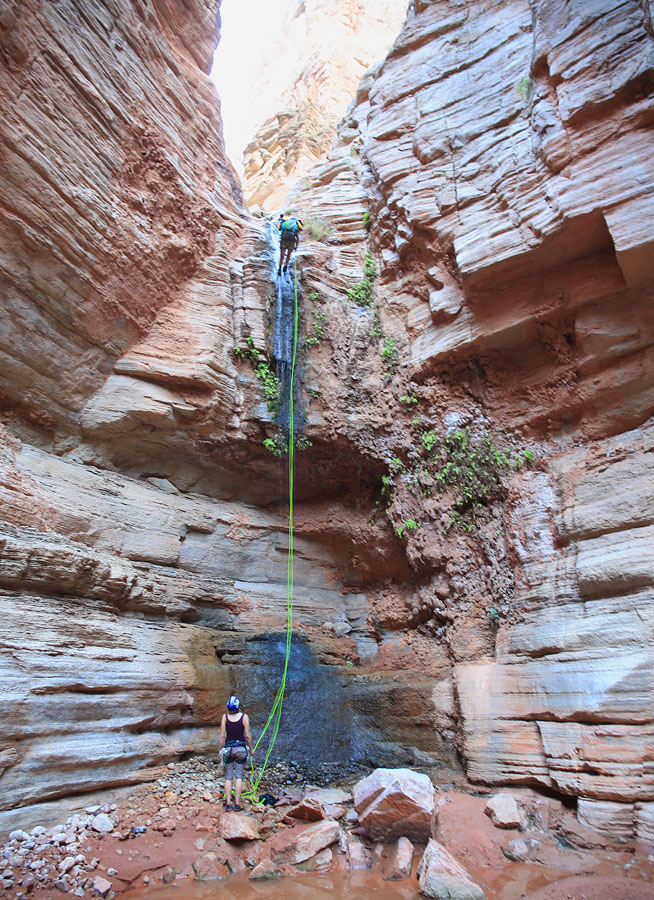Cove Canyon, Grand Canyoneering, AZ
Guest Rave by Cassy Brown. Photos by Lindsey and Lynn.
The moment I watched Lynn stick the burly Zion Adventure Company Land Cruiser BEFREE in a ravine, I knew we were in for an extraordinary adventure in this ruggedly remote corner of the Grand Canyon. “Game on,” I thought. “Let the foolery begin.”
She and I spent the next hour trying to provide the 4WD vehicle with enough traction to escape the ravine. In our efforts, we ripped a gaping hole in a rope bag and broke a packraft paddle in half. No matter what we did to reestablish traction, the wheels would spin out as if the differential wasn’t locked, though we both felt confident it was.
Disheartened, we accepted defeat and returned to Tuweep Campground to see if any other campers would be interested in giving us a haul. I felt confident we would find a willing savior, though Lynn seemed less sure. The first person we asked, Terry, jumped at the opportunity to use his towing tools and experience to help us.
After dinner at camp, Lynn and Jillian set off with Terry to free BEFREE from its sandy resting place. Terry had the vehicles rigged for the haul when Lynn insistently stepped into BEFREE’s driver’s seat once more to have one last shot at solving the problem. As she stepped, her headlamp illuminated the differential-locking dial on the unintuitive, left-hand side of the steering wheel. Dumbfounded we had both missed it before, she engaged the dial, set the vehicle in reverse, and backed out. Simple as that.
A few hiccups later, Lynn and Jillian returned to a slumbering campsite and slept knowing BEFREE was perfectly poised for our motorized escape from Lava Falls.
The lateness of our 8:30 start the next morning was painfully amplified by the inescapable desert sun beating down on us and our oversized packs. By the time we reached the drop-in point, our five-girl team must have wandered 10-11 miles, weaving our way around the fingers of the canyons.
By now we were well into the day, and I knew getting to the confluence with Burro Canyon by dark was out of the question. We took a break once we reached the first in-canyon downclimb.
Once we were geared up with harnesses, helmets, full bellies, and topped-off water reserves, down into the bowels of the Grand Canyon we went. The itinerary called for 10-12 rappels the first day. Keeping up with the agenda seemed like a Herculean task, but we were up for the challenge. Nearly every drop featured an awkward start, an overhang, a water obstacle blocking the landing, or even all three! Welcome to Arizona canyoneering, I guess.
Managing all these variables didn’t bode well re: efficiently for most of the crew. At the time, I thought zipping packs down some of the one-stagers would save time. Looking back, I see the benefits and the hindrances of the zip-line, though I cannot be sure whether setting them up helped or hurt our time.
Eventually, we found our rhythm and grooved to our mellow tempo. Between rappels, fields of massive boulders littered the canyon floor: a boulder hopper’s paradise.
Shortly after we descended the next sequence of rappels, the waning sunlight forced us to hunt for a suitable campsite. Six rappels in, Lynn found a pristine alcove on canyon right where we set up camp on two wide, stair-step slabs. After dinner we settled into our sleeping bags, staring up at the Milky Way framed by the contours of the alcove.
Most of the team was up before sunrise. Lynn woke me up as part of her morning routine. I loved waking up in the Great Outdoors and how getting dressed that morning included a harness, helmet, and huge pack. All day, I could only think “Ah, this is what I live for.”
Our second day could be described as a losing game of catch-up with some foolery sprinkled on top. I had my heart set at eating lunch at the confluence of Burro Canyon, but the canyon met us with relentless, slow-going boulder hopping with a rappel over here and another over yonder. As the morning pressed into the afternoon, I could sense the group was frustrated that we hadn’t made it to the confluence yet.
Early afternoon wore into plain ol’ afternoon when we reached a beautiful 75’ drop into a stunning alcove just before the confluence. As last rappeller, I paid special attention to keeping the ropes away from each other to prevent a difficult pull. I rappelled into the alcove, then down to the canyon floor.
Lynn managed to pull the rope one arm’s length at best before she met resistance. She yanked, walked over here, yanked again, walked over there, yanked, called me over to assist her, we yanked. Next, we tried to flick the ropes over each other to unravel any twists, but the jagged rock gripped the ropes tight at an edge. We climbed 15 feet into the alcove to get a different angle, but no amount of flicking could release the gripped rope.
Deep down I knew it was my time to shine, so I stepped up to the plate and said, “Forget this! I’m ascending.” Lynn wasn’t so animated about my decision and reasoned that ascending should be used as a last resort. Although I would typically agree with Lynn, we had the element of certainty in this scenario. The biner block was at best an arm’s length away from the quicklink, so if my weight was enough to pull the rope back, I could only fall that arm’s length.
When I reached the top, I discovered that despite my efforts the ropes twisted together during my descent. I untwisted the ropes and had Lynn do a test pull with the biner block still in place. The biner scraped reluctantly against the grippy rock and refused to budge once it got to the edge, so we opted to remove the biner and try for a double-strand rappel. Luckily both ends of the rope touch the bottom of the alcove, and the test pull went smooth.
While Lynn and I were fussing around with the ropes, the other three had broken for a meal among the rocks. Once we were all reunited, we soldiered on, past the confluence, where we didn’t even stop. So much for my plans.
We reached our final rappel just as dusk began to fall, so we rappelled out by the light of our headlamps. Jillian found an excellent riverside campsite for us to inflate our packrafts and sleep. The dark water of the Colorado contrasted against the whitecaps in the river looked threatening by starlight, and the trepidation about what tomorrow had in store crept into the forefront of our minds.
The next morning Jillian, former rafting guide, provided a 15-minute rafting lesson before we embarked on our 5-mile journey down the Colorado. She covered river anatomy and features, basic swiftwater survival, and how to stay together. Jillian’s confidence and excitement for what lay ahead comforted some of my anxiety. I felt grateful to have her knowledge and expertise on the river.
Gingerly, we ambled into our tiny boats and pushed away from shore. I was eager to see how my taped-together paddle would hold up in the river. A few strokes in, I became fearful I would fall in without a more functional paddle. I fought to keep the boat pointed down river while I navigated into the eddy on the right. The team met me on a sandbar where we splinted the paddle with a faggot.
My new paddle featured more duct tape, a 12” sling, some accessory cord and a carabiner for good measure. The splinted side of the paddle was at least three times bulkier and heavier than the other side, but it suited my needs just fine.
As we floated through the rapids, the boats filled like bathtubs and their maneuverability became sluggish, so everyone except Jillian had to pull over on numerous occasions to dump the water out.
Just as I was getting comfortable on the river, we arrived at our exit point about a quarter mile upstream from Lava Falls, the largest rapid in the Grand Canyon. While some of us deflated rafts, others worked on filtering water from the muddy Colorado. Too much silt and sand in the river rendered the water unfilterable by ceramics alone. Using Lisol’s shirt, we sifted some of the particles out of the water before we filtered it with our pumps. At this rate, we would be here all day before we had enough water to make it out alive.
While we filtered, deflated, ate, and dried our gear, a large group of rafters on a 16-day expedition floated by. One of the boats pulled over and offered us water, which we graciously accepted. It is remarkable that even in one of the most remote places on earth, we crossed paths with other humans who boosted us for our final push to escape the backcountry. The two rafters from Station 50 of the Phoenix Fire Department commented that they had never seen an all-girls trip of this magnitude and applauded our efforts. It felt good to receive unsolicited validation, but it felt even better to have topped-off water resources on the hike out.
Up the Lava Falls Trail -- over the course of 1.5 miles, we ascended 2500 feet out of the many layers of the Grand. Part-way up, we lost the trail. This navigational error ate up two hours of escape time, but we managed to miss the hottest part of the day because of it. In an effort to solve our navigational dilemma, I belayed Jillian as she free-climbed a sketchy cliff face to find a way up while Lynn took the GPS to hunt for a better route. According to Lynn, our current location was a mere 200 feet from where we lost the trail. That 200 feet was entirely on the most terrifying slope of scree I have ever climbed. Eventually, she found the way after Jillian proclaimed that climbing up the cliff face was frakked up and unsafe.
Jillian climbed back down to “safety,” and everyone rappelled or handlined off my pack to the tiny landing where they could get back on route. As last being at risk, I didn’t have the luxury of a safety rope for my descent, so I took my sweet time trying to exert control over my slow-motion fall.
We hiked the rest of the way out the impossibly steep Lava Falls trail. Jillian and Lisol hauled ass out of there; they really killed it. Those two took BEFREE to retrieve the Flying Dutchman from the campsite we’d vacated three days prior. I was last lady out, arriving at the Lava Falls parking lot just as dusk fell.



























